|

BROTHER AND
SISTER, Chapter
Six
GEORGE MITCHELL
Written by Rick Archer
 |
|
Rick Archer's
Note:
As we shall see,
Maria Ballantyne's brother George Mitchell
is a true American hero. Considering
my admiration for this man, I deeply regret
to say I never had the chance to meet him.
Sorry to say, Mr. Mitchell passed away in
2013 before I ever heard of him. That
said, due to my curious relationship with
Maria Ballantyne, I immediately felt a
powerful connection to this man. Not
just that, I felt
compelled to add George Mitchell's story to
my book.
At first I resisted. Good grief, what
am I doing? I don't even know this
man! I knew why I felt the need to
share the personal story of Maria
Ballantyne, but what business did I have
adding chapters about a man I never met to
my book? But I did it anyway.
Sometimes I do things that do not make a lot
of sense because I have learned to trust my
instincts.
Then one day the answer came to me. My
mistake was thinking the Magic Carpet
Ride was about 'me'.
Wrong. This book is about FATE and how
it affects our lives. During the
course of writing my book, I have come to
realize there are times when I will not be
the focus, but rather a writer given the
responsibility to tell an important story.
Furthermore, due to a unique perspective
gained from my relationship with Maria
Ballantyne, I daresay I am the only person
who can truly explain the amazing role that
FATE played in the life of George
Mitchell.
In his later years, George Mitchell had this
to say.
"I quickly learned that a good
education, hard work, dedication,
willing mentors, and a few lucky breaks
meant the difference between success and
failure."
If ever there was a man who understood the
value of a Simple Act of Kindness, it would
be George Mitchell. I hope you enjoy
reading about him as much as I did writing
about him.
|
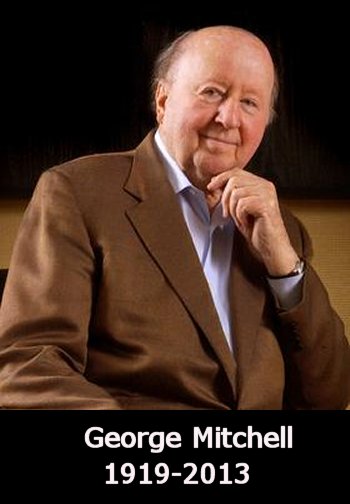 |
HOW RICK
ARCHER DISCOVERED GEORGE MITCHELL
|
Mrs. Ballantyne's stories about 'George'
would drive me crazy. She made it
sound like her brother was rich, but how was
this possible? Given the humble
beginnings which Mrs. Ballantyne and her
brother faced as children, I could not
imagine where his wealth would come from.
My curiosity was always on fire, but not
once did Mrs. Ballantyne offer a clue.
Nor could I look him up. Always
referring to him as 'George', perhaps
he was born with a first name only.
Ultimately, the stumbling block was my
cluelessness about Mrs. Ballantyne's maiden
name.
I discovered George Mitchell's identity
totally by accident one morning in September
2013. I had just started writing my
first book, so I went to the Internet to see
if I could find a picture of Mrs.
Ballantyne. First I typed 'Maria
Ballantyne' into Google. Then I
clicked the 'Images' feature.
A photographer from the Houston Chronicle
had taken a picture of Mrs. Ballantyne
hugging some guy at the 100th anniversary
celebration of Galveston's Hotel Galvez.
I recognized Mrs. Ballantyne immediately,
but not the man. Reading further, the
lower caption said Mrs. Ballantyne was his
sister.
His name was 'George Mitchell'.
George? Oh my, this has to be him!!
I had no idea who George Mitchell was, so I
typed his name into Google. To my
surprise, this man had a Wikipedia profile.
Whoa! That was my first clue there
might be more here than I bargained for.
The moment I read Mr. Mitchell's Wikipedia
profile, I was stunned. George
Mitchell was a billionaire! I just
sat there staring at the screen. I was
so much in awe that my fingers could not
type. Too paralyzed to continue, I
just sat back in my chair trying to wrap my
mind around who this guy was.
Finally I snapped out of it and laughed.
Look who Mrs. Ballantyne has been hiding
from me all this time! Hmm. That
sure was sneaky of her to change her last
name.
The more I read about George Mitchell, the
more amazed I became. I knew Mrs.
Ballantyne kept saying her brother was
special, but, well, this guy was way beyond
special.
I would like to share the details of George
Mitchell's life. After I explain some
of what he accomplished, I have something
very curious to add you would never know
unless I told you.
|
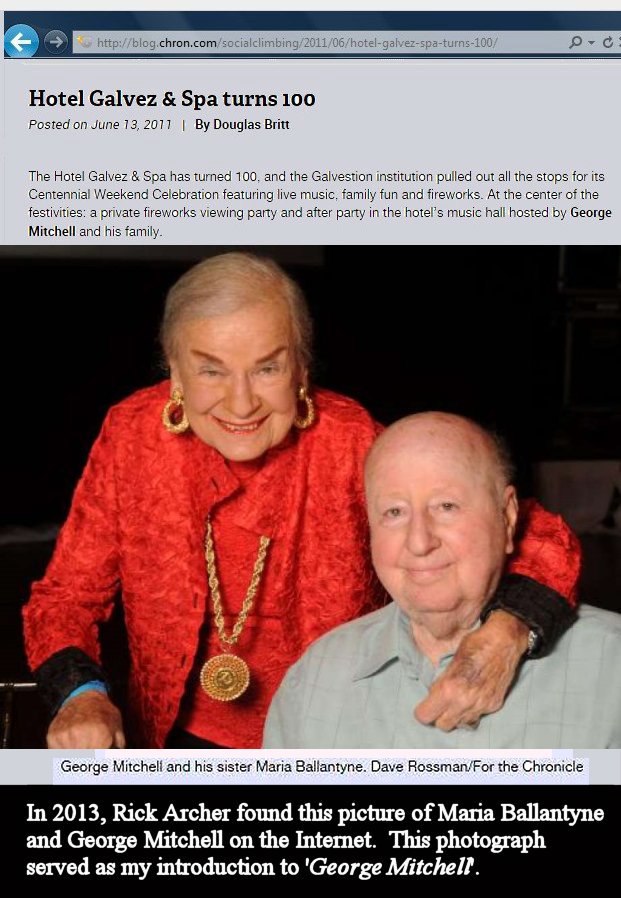 |
George Mitchell had an amazing career.
He was an energy tycoon, real estate
developer, and philanthropist. George
Mitchell graduated first in his class of
1940 at Texas A&M with degrees in
petrochemical engineering and geology.
However, he also graduated without a cent to
his name. Not a problem.
Mitchell would parlay his education into a
legendary career.
Mitchell spent four years in the Army Corps
of Engineers during World War II. Afterward,
he ventured out with his older brother
Johnny on a wildcatter operation. His
early success led to the formation of
Mitchell Energy & Development.
George Mitchell used his A&M training plus
his God-given talent to sniff out the right
places to drill. His oil company was
credited with 200 oil and 350 natural gas
discoveries.
Mitchell is called the 'Father of
Fracking', the extraction of gas from
shale. Ignore the controversy.
When used properly, Fracking (short for 'hydraulic
fracturing'), provides untold economic
benefits with minimal environmental
drawbacks. (When used improperly,
well, that is a different story.)
Fracking uses pressurized water to crack
open rock formations in order to release oil
and natural gas. No one had succeeded
until Mitchell came along. Nor did
success come quickly. Throughout his
15 years of failure, Mitchell was forced to
endure the wisdom of the crowd that said it
could not be done. Like Thomas Edison,
Mitchell was one of those people who refused
to quit till he got it right. Thank
goodness he stayed with it. Mitchell's
shale revolution freed America from its
heavy dependence on Arab oil.
|
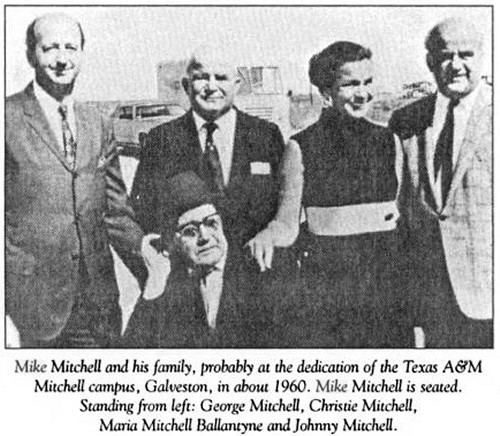 |
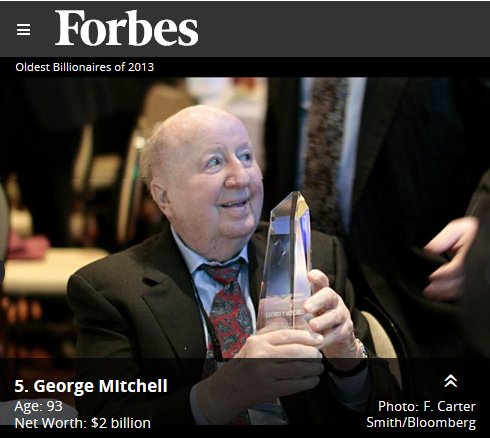 |
Daniel Yergin is
an energy expert best known for The Prize, a
Pulitzer-winning look at the history of the oil industry.
Yergin gave George Mitchell high praise.
"It took a
decade and a half of conviction, investment and dogged
determination. But before Mitchell was done, he
launched what has proved to be the most important
innovation in energy so far this century. Thanks
to George Mitchell, the United States was finally able
to achieve energy independence from the Arabs."
However, it was
not easy. It took 15 years to develop this technique.
Dan Steward, a geologist with Mitchell Energy, had this to
say.
"There's
no point in mincing words. Many people thought
Fracking was a stupid idea, even those in Mitchell's own
company. In the early years, probably 90% of the
people in our firm didn't believe shale gas would be
profitable. It took forever to see results.
Mitchell's company did not cover the cost of fracking on
shale tests until the 36th well was drilled. So
give credit to George Mitchell. He was a tenacious
visionary. There are not a lot of men that would
stay with something this risky as long as he did.
Because of Mitchell's persistence, we are today
witnessing an unprecedented boom in domestic energy
production."
Upon his passing
in 2013, Forbes Magazine ranked George Mitchell the 239th
richest American with a net worth of $2 billion.
|
“Mr. Mitchell’s role in championing new drilling and production
techniques like hydraulic fracturing is credited with creating
an unexpected natural gas boom in the United States."
-- New York Times
|
“George Mitchell is the father of fracking.
Mitchell's
fracking technique is
by far the most
important energy
innovation of this century.
It is because of George Mitchell that today we
are able to talk seriously about ‘energy
independence’ here in the United States."
-- Daniel Yergin,
oil-industry historian
|
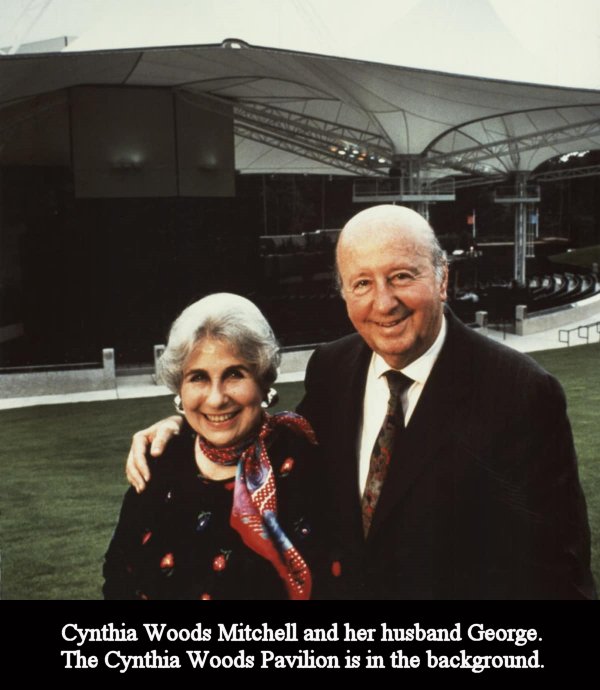 |
George made sure the entire Houston
community knew about his wife Cynthia.
Even me, Mr. Clueless, knew about Cynthia.
That is because the Cynthia Woods
Mitchell Pavilion is famous in
Houston circles.
Located in The Woodlands, the
Cynthia Woods Mitchell Pavilion is a well-known music
venue north of Houston. Many of the
biggest names in the music industry have
performed there. For years, I had heard of
various rock concerts and music festivals
held at the Cynthia Woods Mitchell Pavilion.
However not once did I have any idea who
Cynthia Woods Mitchell was.
George Mitchell
was first and foremost a family man. Mr. Mitchell
enjoyed a loving relationship with his wife Cynthia that was
one for the ages. Married for 52 years, sadly Cynthia
passed away in 2009. She was 87 at the time.
They had 10
children. Pamela Maguire, Meredith Dreiss, Scott
Mitchell, Sheridan Lorenz, Mark Mitchell, Kent Mitchell,
Greg Mitchell, Kirk Mitchell, Todd Mitchell and Grant
Mitchell.
Mr. Mitchell had
a sweet way of acknowledging his special wife... he liked to
name places after her. A good example of his
interesting trait was the Pavilion. In 1982, civic
leaders and members of the Houston Symphony approached
George Mitchell with the idea to establish a summer home for
the symphony in The Woodlands. The facility was
envisioned as a place where performing arts groups and
contemporary entertainers could play.
Mitchell said he would
be more than happy to help. He donated the funds necessary to
make this outdoor amphitheater a reality. While he was at it,
Mitchell made sure to immortalize his beloved wife by naming the
arena after her.
The spacious arena seats
16,000 people. It has become the second-most heavily used
amphitheater in the world.
|
The Woodlands is an
extremely affluent city built in the Seventies by George Mitchell.
Lying 30 miles north of Houston, as of 2020, its population was
110,000. I always thought the Woodlands got its name from
being built inside a dense forest. Silly me. The
Woodlands was named for George's wife
One day Mr. Mitchell was
wondering what to call his new city. Why not name it after his
wife Cynthia Woods? Considering his town was nested inside a
thick Texas pine forest, 'Woods-land' had a nice ring to it.
Woodlands was even better.
Using a government loan,
Mitchell went to work. Immediately the critics surfaced.
They noted that the HUD New Town program had a 'low survival rate'.
They questioned whether the federally-funded Woodlands project would
succeed.
If these critics knew
George Mitchell, they would realize what a favor they had done for
him. Mitchell loved being told what he couldn't do. His
ambitious project included a conference center, hotels, office
parks, retail malls, schools, large distribution centers, homes and
beautiful golf courses.
George Mitchell said he
wanted his development to be so special that it would "entice
city slickers who were looking for far-flung suburban quality of
life."
One way he could do this
was to preserve as much of the surrounding forest as possible.
Mitchell was an early conservationist who became a persistent voice
for environmentally-responsible economic growth. Mitchell
wished to demonstrate how civilization and nature could be
intertwined harmoniously if humans were willing to use sufficient
imagination.
With these ideas in
mind, he created
The Woodlands by building homes and commercial areas
to exist in harmony within the beautiful pine forest. The
master plan called for preserving trees, protecting the environment,
minimizing flooding and creating ways to blend homes and forest
together.
The Woodlands
won a Special Award for Excellence in 1994 from the Urban Land
Institute. One can only wonder what those critics had to say
now. Indeed, Mitchell's understanding of how to integrate
modern technology with environmental responsibility was light years
ahead of its time. People have called The Woodlands the
'City of the Future'.
The development was so
beautiful that one corporate executive after another fell in love
with the place. However these bigwigs didn't like the long
commute to downtown Houston. So what did they do? They
moved their headquarters out to The Woodlands!!
George Mitchell was definitely ahead of his time. The man had
the ability to envision things like few other people. But lots
of people have good ideas. Most quit at the first sign of
negativity. Not George Mitchell. What set Mitchell apart
was his ability to make it happen. Mitchell possessed the
dogged determination to get his vision accomplished despite all the
obstacles and all the naysayers.
|
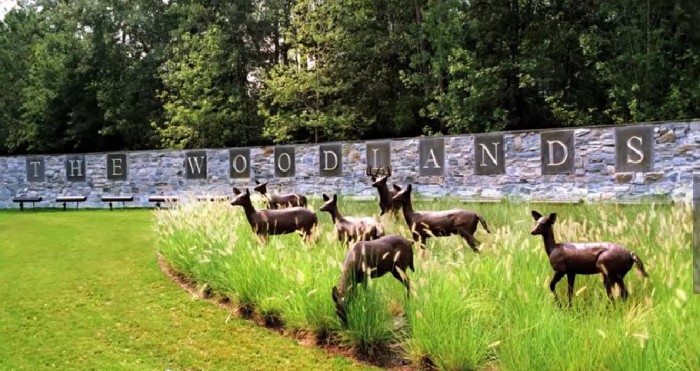
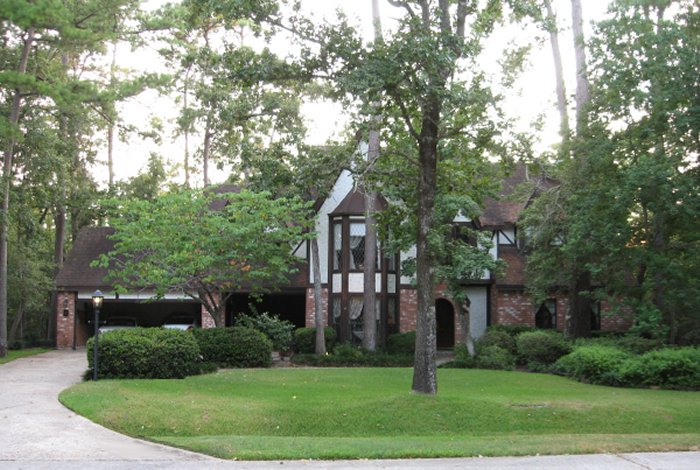
 |
 |
Cynthia Woods had an interesting sense of humor.
Considering she was humble and and unpretentious, Cynthia
laughed at how her husband's curious quirk had given her a
pop culture status. She loved to tease him about it.
"Gosh,
George, let's call your next city 'The Cynthia'.
Or we could rename your annual Mardi Gras party and call
it 'The Woodpeckers Ball'. What about your
Dickens on the Strand idea? We could have the
Parade of the Cynthia Wooden Soldiers!"
Cynthia Woods
did a lot more than help her husband George find convenient
names. She served as an inspiration to George Mitchell
throughout their time together. Cynthia Woods was born
in 1922 in New York City. She and her identical twin
Pamela moved to southern Illinois at the age of eight.
Ms. Woods was an excellent student. At the age of
twelve, she distinguished herself by winning the county
spelling bee.
The family fell upon hard times during the Great Depression.
In search of work, the teenage twins and their mother moved
to Houston in 1938. Both girls supported their mother
as teenagers while simultaneously attending night school at
the University of Houston.
The story of how
George and Cynthia met is special. However, they had
each had a different version. Cynthia's version is
cute, but tame. Following the 1941 Thanksgiving
football game between the University of Texas and Texas A&M,
Cynthia was introduced to a young A&M cadet named George on
the train ride back to Houston. It seems George was a
buddy of sister Pamela's boyfriend. Cynthia was not
happy with her blind date because he had been drinking
heavily. Not just that, Cynthia sensed there was
something special about this George guy. He seemed
intelligent, something she liked. In order to check
George out, first she needed to free herself for a
conversation.
First Cynthia
whispered to Pamela. Then Pamela persuaded her
boyfriend to lure Cynthia's inebriated date elsewhere on the
train for a while. Sitting close by in another seat,
George had been eyeing what was going on. He had a
hunch it had something to do with him. Seeing the
opening, George wasted no time occupying the vacant seat
next to Cynthia. Moving fast, George got Cynthia's
phone number before her date could reappear.
George's version
of the event is much better. His humorous retelling is
similar to an old joke.
Q: What is the fastest way to get the
attention of a pretty girl?
A: Hang the Congressional Medal of
Honor around your neck.
While serving in
the U.S. Army Corps of Engineers during World War II, George
took time off to see the football game. George was
returning to Houston on the same train as Cynthia.
Everyone was in a bad mood because A&M had been undefeated
until today. Unfortunately the Texas Longhorns had
come to College Station and soundly defeated the Aggies
23-0.
In Mitchell's
own words:
"So here I
am on the train. There are these two attractive
girls, twin sisters, identical, both beautiful, both
smart. The one I liked best had a blind date with
an A&M senior. He wasn't paying any attention to
her because he was still upset over the loss.
Me? I
had forgotten about the game. I was more worried
how I was going to get this girl's phone number with
this guy in my way. Cynthia must have sensed my
interest because she somehow persuaded her date to go to
the back of the car to run an errand. Aha, I
smiled, this is my big chance. To my
consternation, the guy wouldn't leave. Maybe he
was smarter than I gave him credit for. I guess my
interest in Cynthia was written all over my face because
the guy stared darts at me. As he was checking me
out, just then he noticed my open bag and saw something
shiny.
I had won
some sort of tennis medal. I was captain of the
A&M tennis team and all that stuff. He recognized
the A&M insignia, so he grabbed my medal and pulled it
out. The tennis medal was loosely attached to a
gold watch. When the watch fell on the floor,
Cynthia noticed. She asked if it had any
significance. I explained I had won the watch as
the top engineering student of A&M.
Once I said
that, Cynthia's expression changed on the spot. I
will never forget her smile. She slipped me her
number and we started dating. We were married a
year later on Halloween Day. Cynthia was a
wonderful wife and a wonderful mother. We had 10
children. I loved her so much. Everything I
did, we did together... family, philanthropy, rebuilding
Galveston. She was the love of my life."
|
George Mitchell loved
Texas A&M with a passion. He also loved astronomy.
Dreaming of becoming an astronomer, in high school he had built his
own telescope to help satisfy his curiosity. Mitchell loved to
learn about outer space. Assuming he would study astronomy in
college, throughout high school he concentrated on math, physics and
chemistry.
However, one summer his
brother Johnny arranged a summer job in the oil patch. At this
point Mitchell became enthralled with the hunt for petroleum.
Realizing the search for oil would be a more profitable profession
that looking for life on other planets, Mitchell dedicated himself
to petroleum engineering.
One of George Mitchell's
greatest traits was his loyalty. He understood that the
education he received at Texas A&M was what enabled him to become a
success in his chosen field. Consequently over the course of
his life, George Mitchell donated $160 million dollars to the
school. In so doing, Mitchell became the greatest benefactor
in the history of Texas A&M. George Mitchell is a legend at
his alma mater and deservedly so.
As he aged, Mitchell
still wanted to explore the mysteries of the Universe. He
talked about it so much that his friends teased him about his love
of outer space. His friends called Mitchell 'The
Star-struck Billionaire'. Sadly, Mr. Mitchell's passion
for astronomy set him up for his greatest disappointment.
George Mitchell did not have many letdowns in his life, but there
were a few. Mitchell's greatest disappointment was the failure
of the Texas Super Collider Particle Accelerator.
A particle accelerator
is a device that uses electromagnetic fields to propel charged
particles to high speeds and contains them in well-defined beams.
The idea is to unlock the secrets of the atom. When completed,
the Supercollider would have allowed the U.S. to retain dominance in
high-energy physics.
Mitchell was
instrumental in getting the Superconducting Super Collider project
approved by President Ronald Reagan in the 1980s. Sadly, it
was killed off in the 1990s due to serious cost overruns, leaving
the project half finished. Had the Supercollider been
completed, it would have boosted energy 20 times larger than any
accelerator ever constructed. Mitchell was devastated at his
loss. This had been his baby. It took him a long time to
get over this setback.
As a visionary, one can
assume that Mitchell understood the practical long-term benefits of
this project far better than the average man. But there was
nothing he could do about it other than accept defeat... something
he wasn't used to doing.
Picking up the pieces as
best he could, Mitchell quietly saved the Alpha Magnetic
Spectrometer being built at Texas A&M and funded research to create
stronger magnets to help in cancer research. The list just
goes on and on. Watching Mitchell mope around, one day a
friend said, "If you love astronomy so much, why not build something
over at A&M?"
What a great idea!
Since Mitchell was dying to renew his love of all things
interstellar, why not build an Astrophysics center indeed!
Boys and their toys, right?
First Mitchell helped
fund the Giant Magellan Telescope high in the Andes Mountains of
Chile. Then for good measure, in 2002, Mitchell endowed the
Mitchell Institute for Fundamental Physics and Astronomy, an
astrophysics lab designed to research the complex issues of the
universe.
Mitchell needed someone
to get his institute off to a rousing start, a celebrity of some
sort. Mitchell knew just the guy: Stephen Hawking, the world’s
most famous scientist.
George Mitchell had
originally met the physicist during his pursuit of the Supercollider
project. Hawking was impressed at the depth of Mitchell's
interest and knowledge in his work. Mitchell was equally
impressed with the professor's profound insight into the mysteries
of life. The two men formed a deep friendship.
Mitchell brought Hawking
to lecture at A&M on four different occasions. During
Hawking's stay, the world-renowned physicist would delight in
traveling across campus in his wheelchair. He loved to
interact with hero-worshipping students who greeted him with a
Texas-sized "Howdy, how ya doin', Dr. Hawking!"
George Mitchell had to
grin. Nothing like a warm Aggie welcome for the world's most
famous scientist!
"Stephen loved to go
out across campus in his motorized wheelchair and surprise
people. He would scoot from the Student Center across to
the Physics building. Many an Aggie student stopped in
their tracks upon seeing Stephen Hawking roll across campus with
a big smile on his face. "Is that who I think it is??"
Stephen enjoyed their enthusiasm and liked having them say hello
to him. This chance to connect to the awestruck students
was very special for him."
In addition to their
intellectual brilliance, both men had a sense of humor. Late
in his life, George Mitchell was no longer able to walk.
Mitchell, like Hawking, was confined to a wheel chair. Did
Mitchell, once the fastest tennis player on his team, mope about his
problem? No, of course not. Competitive as always,
Mitchell challenged Hawking to a wheelchair race. Next thing
you know, the two friends were racing each other down the A&M
corridor.
So now you have met
George Mitchell. Father. Astronomer. Oil man.
The guy who freed America from Arab oil dominance. Created an
amazing city. Became the greatest philanthropist in Texas A&M
history. What does a guy like that do for an encore?
|
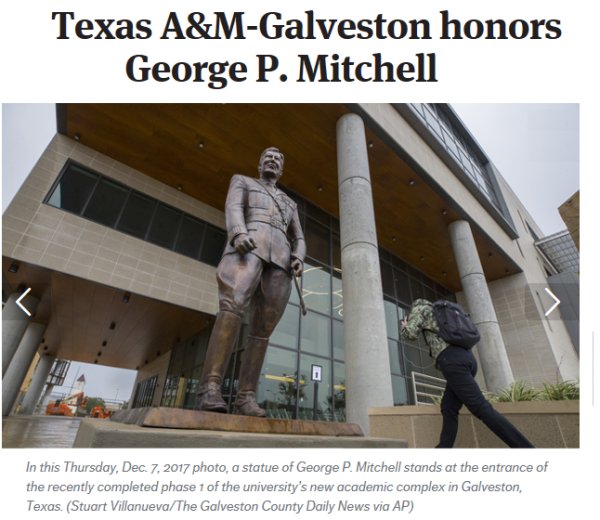
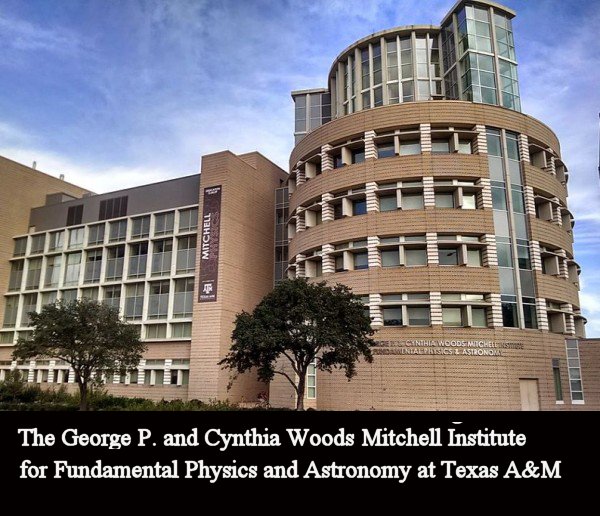
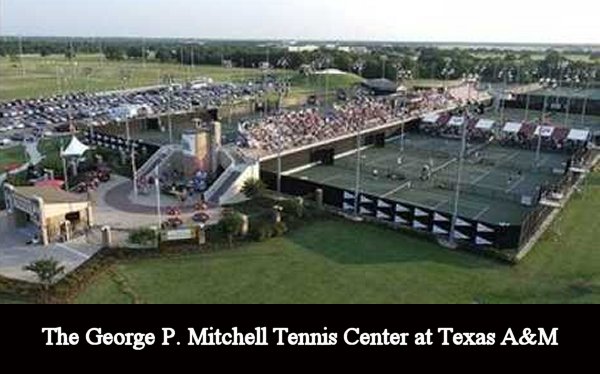
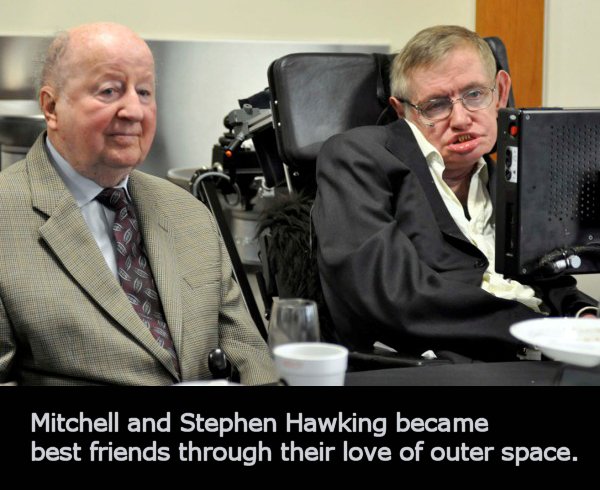
|
|
|